When the name Eric Lindros is mentioned, most people remember the dynamic winger who tormented the league as a member of the Philadelphia Flyers. Some others will say his trade is possibly the only time in NHL history where a team has moved away from a star player and perhaps been better for it. Many people have revisited the Lindros trade, but very few have seen how it affected both organizations for the foreseeable future. This is a monster deal that changed the shape of the league forever. This is the Eric Lindros trade tree.
Lindros Before the Draft
In the beginning, slightly after man created fire, a young kid was in the ranks of the Oshawa Generals. At 6-foot-4, 230 pounds, Lindros had the size to run through people. Unfortunately for kids in the Ontario Hockey League then, the world was about to discover that Lindros was not a one-trick pony. In his first season with the Generals, he had 17 goals and 19 assists for 36 points in 25 games. That’s not bad. But after that, he went nuts. In his draft year of 1990-91, he played 57 games and recorded 71 goals and 78 assists for 149 points, the 14th-highest point total in an OHL season ever.
Related: Eric Lindros: A Player Who Changed Hockey Both On and Off The Ice
Lindros became the clear favorite for the first overall pick with this explosion. If you are old enough to remember this season in the NHL, the Toronto Maple Leafs traded that year’s first-round pick. They were desperately trying to pick up anti-tanking measures from the Quebec Nordiques to ensure they did not give Eric Lindros to the New Jersey Devils. With this, the Nordiques secured the first overall pick, and they would get to draft Eric Lindros. Everything looked suitable for the Nordiques. But if only things were ever that easy.

Lindros refused to sign his contract with the Nordiques. At the time, no one knew why, so fans assumed it was because of the language, city, or culture. It was later revealed during an interview Lindros did with Sportsnet that his issue was not with the organization but with the Nordiques owner Marcel Aubut. Not knowing this at the time, Lindros was labeled as a baby, and Nordiques fans started to wear diapers to games mocking Lindros’ decision. Quebec’s general manager at the time, Pierre Page, was unwavering in his demands to move Lindros, so he stayed on the Nordiques reserve list until the Flyers came calling.
Lindros’ Trade to Philadelphia
On June 30, 1992, we had a trade to shock the hockey world. The Nordiques acquired Steve Duchesne, Peter Forsberg, Ron Hextall, Kerry Huffman, Mike Ricci, Chris Simon, a 1993 1st-round pick, a 1994 1st-round pick, and $15 million in cash in exchange for Lindros. You’re not reading this wrong. There were eight pieces and $15 million moved for Lindros. This is still one of the biggest deals the league has seen more than 32 years later.
Let’s start with the Flyers’ side because we will have to talk about the Nordiques for a while. Lindros was everything he was built up to be as a member of the Broadstreet Bullies. During his rookie season, he came fourth in Calder voting. This was the year Teemu Selanne had 76 goals as a rookie, so he was never likely to win it. His 41 goals and 34 assists in 61 games earned him a place on the all-rookie team that year. He followed that up with a 44-goal and 53-assist performance the following season in 65 games. He didn’t win anything that year, so he put the world on notice the season after.
Legion of Doom
Lindros was united with John LeClair and Mikael Renberg during this season. This line almost instantly started dominating physically and offensively, earning them the nickname “Legion of Doom.” All three guys stood 6-foot2 or taller and weighed more than 230 pounds. Lindros had 29 goals and 41 assists for 70 points in a lockout-shortened season in 1994-95. This won him the Hart Trophy as league MVP and the Lester B. Pearson as league MVP voted by the players.
Related: Remembering Mikael Renberg on the Legion of Doom
In 1995-96, Lindros went insane, having the best year of his career. He took the league by storm with 47 goals and 68 assists for 115 points in 73 games during the peak of the dead puck era when scoring was impossible. This season would see him come third in Hart voting and 20th in Selke voting for the best defensive forward.
One thing you’ll quickly notice when looking at Lindros’ stats is that he could never play an entire season. Injuries plagued him, and they got worse over time. After his final season with the Flyers in 1999-00, he missed the entirety of the 2000-01 season because of injury. His final totals as a Flyer were 290 goals and 369 assists for 659 points in 486 games during the dead puck era.
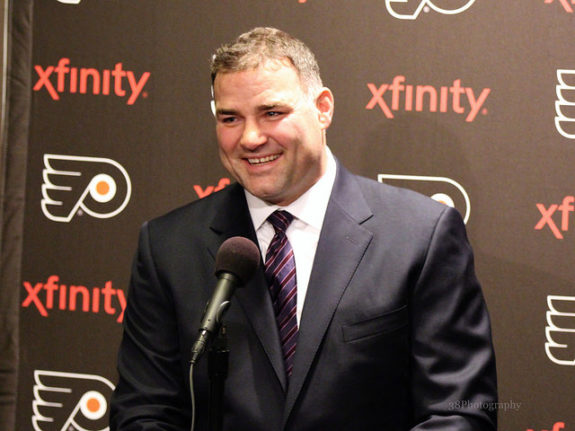
Lindros came back in the new millennium. Still, he was never able to return to being Lindros and retired after the 2006-07 season after recording 372 career goals and 493 career assists for 865 career points in 760 career games. He was voted into the Hockey Hall of Fame in 2016 and, in 2017, was named one of the 100 greatest players ever.
Nordiques Start to Build a Dynasty
To refresh, Quebec got Duchesne, Forsberg, Hextall, Huffman, Ricci, Simon, a 1993 1st-round pick, a 1994 1st-round pick, and $15 million in cash. Cash in deals like this is now against the collective bargaining agreement, but that money on top of eight assets should show you how highly the Nordiques thought of Lindros. As for the rest, where do we start?
I guess let’s start with Huffman because this one is simple. He played in 80 games as a member of the Nordiques and recorded four goals and 24 assists for 28 points. The Ottawa Senators claimed him off waivers during the 1993-94 season. He had a nice career, but the bulk of it was away from this organization, meaning he is not needed for the future of this trade tree.
The Hockey Hall of Famer
Forsberg was the only other player involved on the Nordiques side that did not get dealt, so this is the follow-up. Peter Forsberg walked into the league as a young star, and his 1994-95 rookie season proves it. In 47 games, he had 15 goals and 35 assists for 50 points. This was enough to win the Calder Trophy as the league’s best rookie. He was also named to the all-rookie team.
Related: Peter “Foppa” Forsberg: A Biography
In 1995-96, Forsberg was no longer a member of the Nordiques team because the organization relocated. Now in Denver, the Colorado Avalanche had their young star explode for 30 goals and 86 assists for 116 points. This was something he did a lot. During his time as a member of the Avs, Forsberg also captured the Hart Trophy as league MVP and the Art Ross as the league’s top point producer in 2002-03 with 29 goals and 77 assists for 106 points. During nine years with the franchise, he played in 580 games, recording 216 goals and 525 assists for 741 points.
When he left Colorado during the lockout lost season in 2005-06, he joined the Flyers. He played 100 games as a Flyer and even had 30 goals and 85 assists for 115 points before he got traded to Nashville. In 17 games with the Predators, he had two goals and 13 assists for 15 points. He tried to rejoin the Avalanche, but injuries had started to destroy his career. Forsberg went back to Europe for a few years until 2010-11, when he had a two-game comeback, but by that point, he was done. His iconic number 21 is one of six to hang from the roof of Ball Arena in Denver.
Colorado Adds Patrick Roy
The Nordiques used the 1993 first-rounder they got back from the Flyers draft Jocelyn Thibault. A good goalie in his own right, Thibault had a .897 save percentage and a 2.96 goals-against average during his three years with the Avalanche and the Nordiques. It was in 1996 that the Avs decided goaltending was a problem, and they wanted to address it with another star to add to the collection. There just so happened to be an unhappy netminder in Montreal.
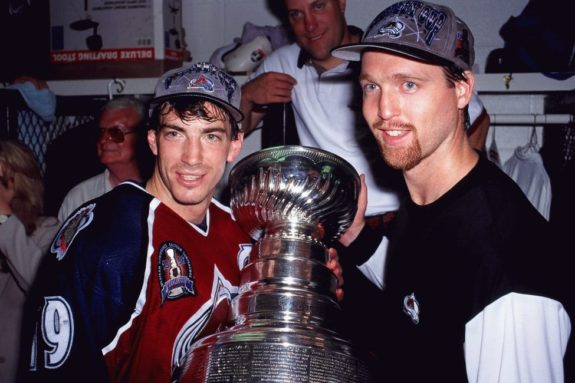
After famously not getting pulled after giving up seven goals in a nine-goal explosion by the Detroit Red Wings, Patrick Roy demanded a trade on his way off the ice. With the Avalanche all too willing to mess with their former provincial rivals and eager to make a splash with their first season in the Rocky Mountains, the Avalanche dealt Andrei Kovalenko, Martin Rucinsky and Jocelyn Thibault to Montreal in exchange for Mike Keane and goaltender Patrick Roy. Roy’s number hangs alongside Forsberg’s in Ball Arena after his eight years in Denver.
I shouldn’t need to tell you how good Roy was, but he had a .918 save percentage and a 2.27 goals-against average during his 478-game career in Colorado. He’d win the Conn Smythe in 2001 and the William M Jennings for lowest goals against in 2002. Keane had four years in Colorado, recording 223 career games, scoring 27 goals and 37 assists for 64 points. During the dead puck era, it’s not a bad total.
Chris Simon’s Branch
Chris Simon is where we will go next. He spent four years in the Nordiques organization and even traveled across the continent with them when they relocated to Colorado. While he was not one of the big cores that Colorado built a dynasty on, he still added 24 goals and 32 assists for 56 points in 146 games. Simon was dealt after the Avalanche won the 1996 Stanley Cup in their first season in Colorado. He was packaged with Curtis Leschyshyn and sent to the Washington Capitals in exchange for Keith Jones, A 1998 1st-round pick, and a 1998 4th-round pick.
Jones spent three years in Colorado, tallying 28 goals and 29 assists for 57 points in 102 games before getting traded. Colorado got Shjon Podein from the Flyers in exchange for Jones. Podein spent four years in Colorado, scoring 34 goals and 37 assists in 239 games. He even won the King Clancey Memorial Trophy, awarded to the player who shows leadership on the ice and away from the rink, usually with charitable donations or humanitarian efforts. Podein would get traded to the Blues in exchange for Mike Keane. Yes, the same Mike Keane that got moved alongside Patrick Roy. This was six years after that deal, though. Once again, he’d leave in free agency.
The 1998 first they got would get traded with another 1998 fourth and a 1998 fifth to move up into the third round of the 1998 NHL draft. They used that to select Evgeny Lazarev, who never got traded. That 1998 first they got with Jones became Scott Parker. He played in 237 games for the Avalanche, scoring five goals and getting 11 assists for 16 points before he got dealt to the San Jose Sharks for 2003 fifth that became Brad Richardson. Richardson played in 136 games with the Avalanche, scoring 19 goals and 21 assists for 40 points. He was dealt to the Kings for a 2008 second-round pick. That was used on Peter Delmas, who never developed but never got traded.
Mike Ricci’s Branch
We’re almost halfway through this trade tree and move on to Mike Ricci. Ricci played in parts of six seasons with the Nordiques organization. In 339 games with the organization, he had 91 goals and 137 assists for 228 points. He was traded to the Sharks alongside a 1998 second-round pick that became Jaroslav Kristek for Shean Donovan and a 1998 first-round pick. That pick? Alex Tanguay. Donovan never got dealt despite playing 133 games for the Avalanche, scoring 13 goals and 19 assists for 31 points.
Tanguay was a long-time servant of the Avalanche and had two different stints with the hockey club. During his nine years playing with the team, he appeared in 598 games and grabbed 167 goals and 321 assists for 488 points. He was a monster for the Avalanche, winning the Cup in 2001. If you want a fun Tanguay fact, he was traded away from the Avalanche twice and dealt to the Calgary Flames both times. The first time is the only thing we’re interested in here, as the return was Jordan Leopold, a 2006 second-round pick, and a 2007 conditional second-round pick. Those picks would get used on Codey Burki and Trevor Cann, respectively, but neither worked out or was traded.
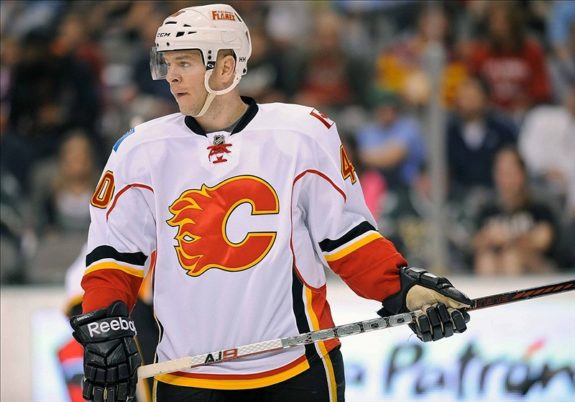
This leaves us to follow the Leopold trail. He spent three years in Colorado, playing in 122 games and netting 13 goals and 25 assists for 38 points. He’d get traded back to Calgary for Lawrence Nycholat, Ryan Wilson, and a 2009 second-round pick. That pick would get used on Stefan Elliott. Nycholat played in five games with the Avalanche, with no production, and he would not get traded. Ryan Wilson played six years for the Avalanche in 230 games, scoring seven goals and 60 assists for 67 points. He was not dealt, either. Elliott played four seasons with the Avalanche, scoring six goals and 12 assists for 18 points. He’d get traded for Brandon Gormley from the Coyotes. Gormley played in 26 games with the Avs and had one assist.
Ron Hextall’s Branch
We have to go back to 1993 to make progress in this deal. Hextall played 54 games for the organization, posting a .888 save percentage and a 3.45 goals-against average before getting dealt alongside a 1993 first-round pick to the New York Islanders in exchange for a 1993 first-round pick and Mark Fitzpatrick. Fitzpatrick left in free agency to Florida, but the first-round pick swap is always interesting. With the 1993 pick that the Nordiques gave up, it was used to select Todd Bertuzzi. As for the first-round pick the Nordiques got back, they used it to make the 14th overall selection in 1993. That was Adam Deadmarsh.
Deadmarsh’s NHL flame did not burn long, but it did burn bright. In 453 games with the Nordiques and Avalanche, he scored 138 goals and 150 assists for 288 points. When injuries started to show signs of plaguing Deadmarsh, he was dealt to the Los Angeles Kings. The deal was Deadmarsh, Aaron Miller, a 2001 first that became David Steckel, 2003 first that became Brian Boyle, and a player to be named later that turned out to be Jared Aulin to the Los Angeles Kings for Steven Reinprecht and Rob Blake.
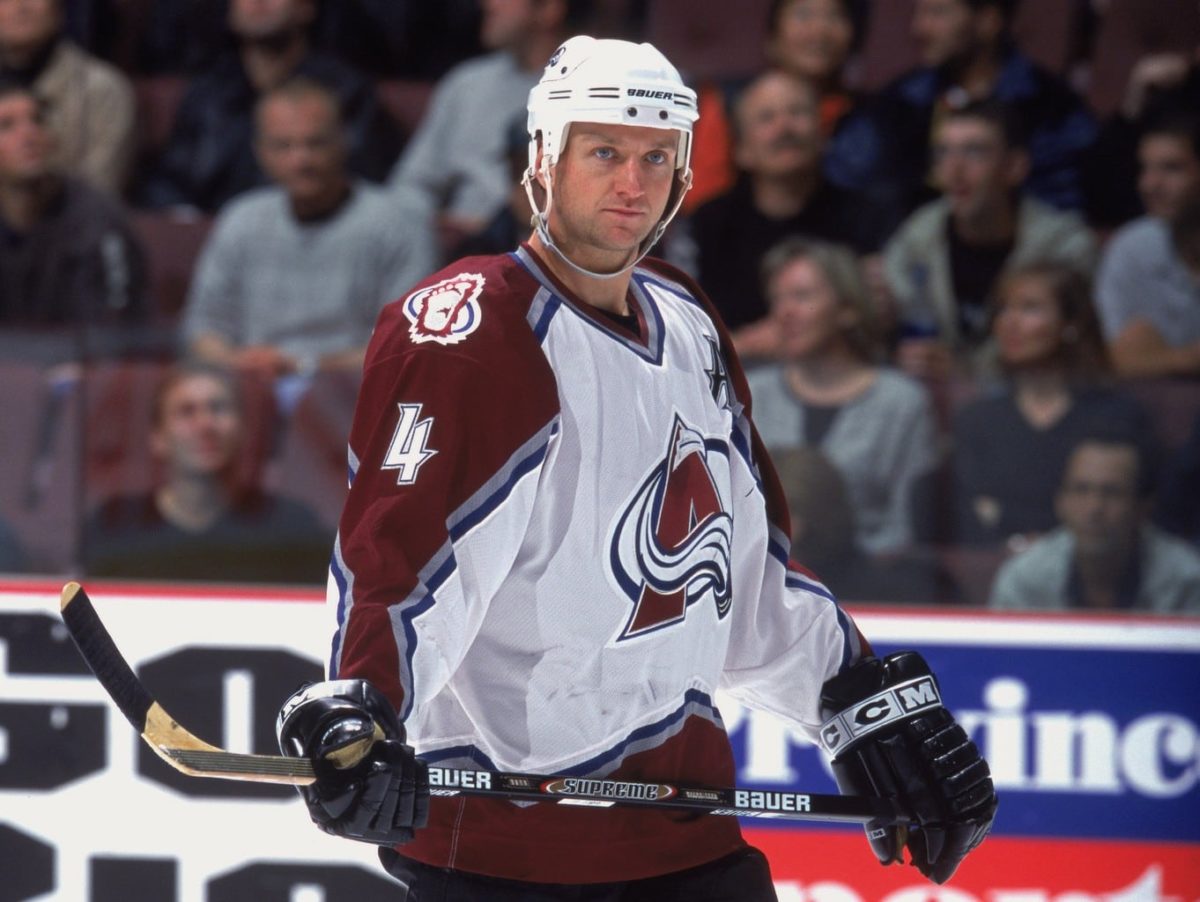
Let’s start with Blake. He was brought in as a rental for the Stanley Cup Playoffs in the hope that he would get the Avalanche over the top. Blake is yet another member of the Hockey Hall of Fame in this tree, and he would get his ring in Colorado in 2001. He would stay in the Mile High City for five years, playing in 322 games and scoring 62 goals and 146 assists. For a right-shot defenseman, this was an incredible tenure. He would depart in free agency, so Blake’s part is over.
On to Reinprecht, who would play in 165 games for the Avalanche, recording 40 goals and 64 assists for 104 points. He’d get dealt to the Buffalo Sabres alongside Rhett Warrener for Keith Ballard. Ballard would get flipped alongside Derek Morris to the Arizona Coyotes for Chris Gratton, Ossi Vaananen, and a 2005 second-round pick that became Paul Stastny. Gratton played 13 games with the Avalanche, recording two goals and an assist for three points. Vaananen played in 139 games, scoring two goals and grabbing ten assists for 12 points. Neither he nor Gratton would get traded.
Paul Stastny, however, oh boy. Following in the footsteps of his father, Peter, and playing for this organization, Stastny played for the Avalanche for eight years. He was in 538 NHL games, scoring 160 goals and 298 assists for 458 points. Stastny leaving in free agency will be in the living memory of most readers at this point. He’s an unrestricted free agent after playing with the Carolina Hurricanes last season.
Steve Duchesne Branch
We’ve got just two assets left from the original deal to follow down the path, and they quickly become connected: Duchesne and the 1994 first-round pick that the Flyers included for Lindros. Duschene played one 82-game season with the Nordiques, scoring 20 goals and 62 assists for a perfect point per game year before the organization decided they had to move him to the Blues. Duchesne would get packaged alongside Denis Chasse in exchange for Bob Bassen, Garth Butcher, and Ron Sutter. Bassen played 84 games for the organization, tallying a rather satisfying 23 goals and 23 assists for 46 points. However, he would not get traded, so we can move into the other two.
Sutter played 37 games as a Nordique, scoring nine goals and grabbing 13 assists for 22 points. He was packaged alongside the 1994 ninth overall pick and sent to the Islanders for Uwe Krupp and the 1994 12th overall pick. The ninth overall pick would turn into Brett Lindros, Eric’s younger brother. With the 12th overall pick, the Nordiques selected Wade Belak. Krupp played 188 games as a member of the Nordiques and Avalanche, scoring 19 goals and 59 assists. Perhaps the most important thing he did in his career was score the Stanley Cup-winning goal in 1996 in triple overtime to complete the sweep of the Florida Panthers. Krupp was not traded, so this branch ends, but we have a whole Wade Belak to discuss.
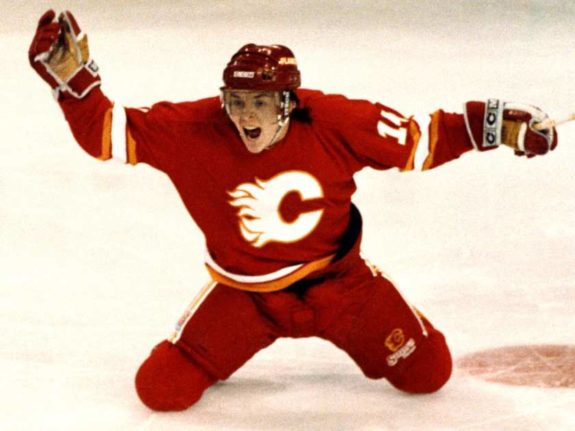
Belak could never breakthrough with the Avs, scoring just one goal and one assist during his 35-game tenure. He’d get packaged with Rene Corbet, a 2000 second-round pick used to select Jarret Stoll, and future considerations in exchange for Chris Dingman and Theoren Fleury. Theo Fleury was brought in as a playoff rental, but it is worth noting he had ten goals and 14 assists for 24 points in 15 regular season games. He left after the year in free agency.
As for Dingman, he played three years with the Avalanche, scoring nine goals and four assists for 13 points in 110 NHL games. He’d get flipped to the Hurricanes for a 2001 fifth-round pick that became Mikko Viitanen, who never played in the NHL. I want to emphasize here the future considerations in this deal were not nothing, but we will get back to this.
1994 1st Branch
If you notice, I didn’t touch on Garth Butcher when he was acquired in the Duchesne deal. That is because he was dealt out of town with the 1993 first-round pick the Nordiques got from the Flyers. Butcher played 34 games with the Nordiques, scoring three goals and nine assists for 12 points before getting sent out of town alongside the pick used on Nolan Baumgartner, as well as Mats Sundin and Todd Warriner for a 1994 first-round pick used on Jeff Kealty, Landon Wilson, Sylvain Lefebvre, and Wendel Clark.
Let’s start with Landon Wilson because that allows us to tie up the remaining loose ends. Wilson spent parts of two seasons in Colorado, playing in 16 games, scoring two goals and two assists for four points before getting flipped to the Boston Bruins. He was packed with Anders Myrvold and sent to the Bruins for a 1998 first-round pick used to select Robyn Regehr. If you’re reading this like, “Robyn Regehr wasn’t an Av,” you’re right. Regehr was part of the Theo Fleury trade with Calgary in the future considerations part. He was never a member of the Avalanche.
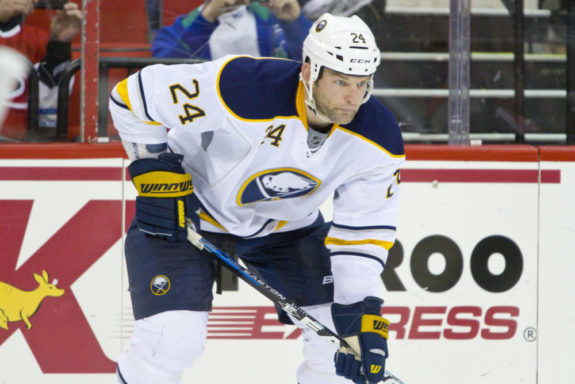
Lefebvre was never traded after the Sundin deal, but he did play in five seasons with the Nordiques and Avalanche. He was on the 1996 Stanley Cup-winning roster, scoring 11 goals and 61 assists for 72 points in 351 NHL games. Kealty not got dealt, meaning we’ve got just Wendel Clark to follow on with. Clark played just one season with the Nordiques and did not follow the team to Colorado. He played in 37 games with the Nordiques, scoring 12 goals and 18 assists for 30 points. He was then sent to the New York Islanders in part of a three-team deal that saw the Avalanche get back the 1995 Conn Smythe winner. That man? Claude Lemieux.
Lemieux did two things well in his career. Score and fight. He played 297 NHL games in Colorado, putting up 106 goals and 106 assists for 212 points. He won the cup in 1996 with the Avalanche before starting an ever-lasting rivalry with one stupid decision. A hit from behind on Kris Draper sparked the hatred that the Avalanche and Red Wings had for years, and it lit a fire under the Red Wings team that had been underperforming in the early to mid-1990s.
“And After 22 Years”
There are just two more trades to cover. Lemieux went back to the Devils with a 2000 second-round pick and a swap of first-round picks in exchange for Brian Rolston. The second-round pick would get used on Matt DeMarchi, and the first-round pick the Devils got turned into David Hale. As for the pick the Avalanche got, they used it on Martin Samuelsson but not by them. Rolston played in 50 games as a member of the Avalanche, scoring eight goals and ten assists for 18 points. However, the 2000 NHL deadline saw the Avalanche a piece away from winning the Cup in the eyes of many, so the final branch of this trade tree was as follows.
Colorado packaged the first from New Jersey, Rolston, Martin Grenier, and Samuel Pahlsson to the Boston Bruins in exchange for Dave Andreychuk and Ray Bourque. It was only fitting that the final trade of this tree sees the Avalanche add two more Hockey Hall of Famers. Andreychuk had just a few months in Colorado, playing in 14 games, scoring one goal and two assists. That was underwhelming, but it was the twilight of Andreychuk’s career, and that is justifiable.
Ray Bourque’s story, on the other hand, is a fairytale. Bourque spent 20 years as a Boston Bruin, winning the Calder as a rookie with 65 points in 1979-80 and winning the Norris Trophy three times in four years at the end of the 1980s and into the early 1990s. He was dominant. However, that Stanley Cup eluded Bourque throughout his career. Trying to walk in the footsteps of Bobby Orr before him, Bourque never had the luxury. So in 2000, the Bruins are tearing it down, and Bourque asks for a trade to try and win the Cup. In 2000, the Avalanche came short as the Devils won the Cup.
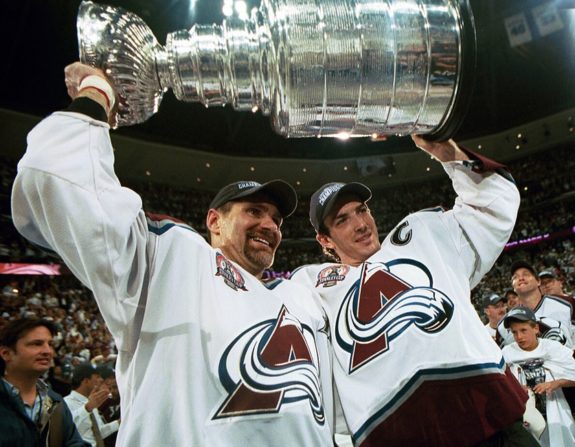
2000-01 would be Bourque’s final season. Would he be able to leave the NHL on top of the world? In 94 games as an Avalanche, Bourque had 15 goals and 58 assists for 73 points. A vintage Bourque performance in the final season of his career. As time ticked down on one of the careers of one of the greatest defensemen to ever put on a pair of skates, the Avalanche went deeper and deeper into the postseason. His dreams came true in Game 7 of the 2001 Stanley Cup Finale. On June 9, 2001, he won the Stanley Cup. His number also hangs in the rafters of Ball Arena.
The Lindros Trade Tree Overall
There are so many layers to this deal. Whether it’s the number of Hockey Hall of Famers this deal brought through the organization, the Flyers getting one of the best players their franchise has ever seen, or how this deal cemented the success the Avalanche had in Colorado in the earliest part of their tenure. Winning the Stanley Cup in 1996 during their first season in the Rocky Mountains essentially happened because of this trade. Winning it again five years later can also be attributed to this trade tree.
Lindros himself was one of the greatest players of the 1990s. Dominating the league and thriving in Philadelphia, he was everything the Flyers could have asked for. As I said right back at the beginning of this, this is one of the few trades in NHL history where the star player dealt did not outweigh the return. Whether you want to see the star power in the original trade or the pieces that appear in this tree that allowed the Avalanche’s dominance after the relocation, this is one of the most fun trade trees.
Sign up for our NHL History Substack newsletter
